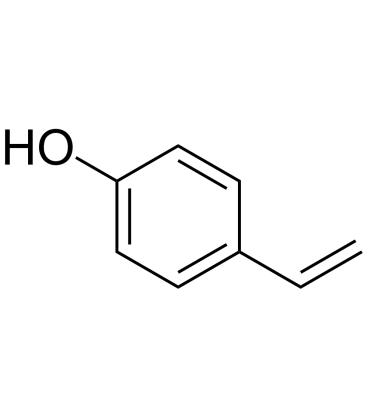4-Vinylphenol (10%w/w in propylene glycol) |
| Catalog No.GC60525 |
El 4-vinilfenol se encuentra en la hierba medicinal Hedyotis diffusa Willd, el arroz silvestre y también es el metabolito del Ácido p-cumÁrico y ferÚlico de las bacterias del Ácido lÁctico en el vino. El 4-vinilfenol induce la apoptosis e inhibe la formaciÓn de vasos sanguÍneos y suprime el crecimiento de tumores de mama invasivos in vivo.
Products are for research use only. Not for human use. We do not sell to patients.

Cas No.: 2628-17-3
Sample solution is provided at 25 µL, 10mM.
GlpBio Products Cited In Reputable Papers
Product Documents
Quality Control & SDS
4-Vinylphenol is found in the medicinal herb Hedyotis diffusa Willd, wild rice and is also the metabolite of p-coumaric and ferulic acid by lactic acid bacteria in wine. 4-Vinylphenol induces apoptosis and inhibits blood vessels formation and suppresses invasive breast tumor growth in vivo[1].
4-Vinylphenol (12.5-200 µg/mL) significantly reduces cell viability in parental MDA-MB-231 cells, and the IC50 value is 109 µg/mL[1]. 4-Vinylphenol (0.15 or 0.3 µg/mL; 3 days) reduces sphere?formation and vimentin expression on CSCs in breast cancer[1]. 4-Vinylphenol (50, 100 µg/mL; 72 hours) significantly suppresses cell proliferation in CSC-enriched MDA-MB-231 cells. 4-Vinylphenol significantly reduces ALDH1A1 expression by 50% in CSC-enriched MDA-MB-231 cells[1]. 4-Vinylphenol (100 µg/mL) significantly increases the expressions of caspase 3, likely sensitizing CSC-enriched MDAMB-231 cells to apoptosis[1].
[1]. Leung HW, et al. The natural agent 4-vinylphenol targets metastasis and stemness features in breast cancer stem-like cells. Cancer Chemother Pharmacol. 2018 Aug;82(2):185-197.
| Cas No. | 2628-17-3 | SDF | |
| Canonical SMILES | OC1=CC=C(C=C)C=C1 | ||
| Formula | C8H8O | M.Wt | 120.15 |
| Solubility | Storage | -20°C, stored under nitrogen | |
| General tips | Please select the appropriate solvent to prepare the stock solution according to the
solubility of the product in different solvents; once the solution is prepared, please store it in
separate packages to avoid product failure caused by repeated freezing and thawing.Storage method
and period of the stock solution: When stored at -80°C, please use it within 6 months; when stored
at -20°C, please use it within 1 month. To increase solubility, heat the tube to 37°C and then oscillate in an ultrasonic bath for some time. |
||
| Shipping Condition | Evaluation sample solution: shipped with blue ice. All other sizes available: with RT, or with Blue Ice upon request. | ||
Complete Stock Solution Preparation Table
| Prepare stock solution | |||

|
1 mg | 5 mg | 10 mg |
| 1 mM | 8.3229 mL | 41.6146 mL | 83.2293 mL |
| 5 mM | 1.6646 mL | 8.3229 mL | 16.6459 mL |
| 10 mM | 0.8323 mL | 4.1615 mL | 8.3229 mL |
In vivo Formulation Calculator (Clear solution)
Step 1: Enter information below (Recommended: An additional animal making an allowance for loss during the experiment)
 g
g
 μL
μL

Step 2: Enter the in vivo formulation (This is only the calculator, not formulation. Please contact us first if there is no in vivo formulation at the solubility Section.)
Calculation results:
Working concentration: mg/ml;
Method for preparing DMSO master liquid: mg drug pre-dissolved in μL DMSO ( Master liquid concentration mg/mL, Please contact us first if the concentration exceeds the DMSO solubility of the batch of drug. )
Method for preparing in vivo formulation: Take μL DMSO master liquid, next addμL PEG300, mix and clarify, next addμL Tween 80, mix and clarify, next add μL ddH2O, mix and clarify.
Method for preparing in vivo formulation: Take μL DMSO master liquid, next add μL Corn oil, mix and clarify.
Note: 1. Please make sure the liquid is clear before adding the next solvent.
2. Be sure to add the solvent(s) in order. You must ensure that the solution obtained, in the previous addition, is a clear solution before proceeding to add the next solvent. Physical methods such as vortex, ultrasound or hot water bath can be used to aid dissolving.
3. All of the above co-solvents are available for purchase on the GlpBio website.
Related Products
- GC17611 Gadodiamide hydrate
- GC45508 MEGX (hydrochloride)
- GC19635 D-Tartaric acid
- GC40037 Linoleoyl-L-carnitine (chloride)
- GC50386 Histone H3 (1-34)
- GC40156 PAR4 (1-6) (mouse) (trifluoroacetate salt)
- GC38623 Fraxinol
- GC34929 PD-1-IN-17 TFA
- GC45429 Dimyristolein
- GC43806 HC Toxin
- GC16930 Adenosine Kinase Inhibitor (hydrate)
- GC60281 P2X3 antagonist 34
- GC13601 Everolimus (RAD001)
- GC17143 Fenretinide
- GC14816 L-Adrenaline
- GC31854 SPL-707
- GC41544 1-Deoxysphingosine (m18:1(14Z))
Reseñas
Average Rating: 5 ★★★★★ (Based on Reviews and 20 reference(s) in Google Scholar.)
GLPBIO products are for RESEARCH USE ONLY. Please make sure your review or question is research based.
Required fields are marked with *


















